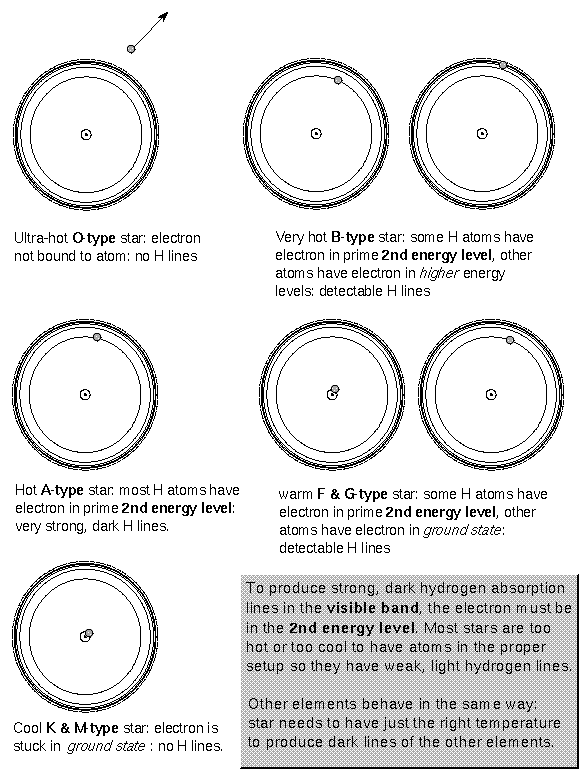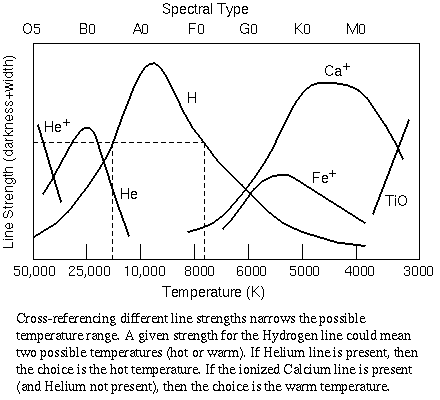1 How Would Astronomers Use the Continuous Spectrum of a Star to Determine Its Surface Temperature
Types of Stars and the HR diagram
Chapter index in this window — — Chapter index in separate window
Video lecture for this page
This section presents the results of using the tools described above. In order to get a better idea of what stars are like, put them into groups of some sort. Then you can see how the other quantities differ among the various groups. Astronomers group stars into general types based on their temperature. Temperature is chosen because the color of a star depends on the temperature and color is a easily seen characteristic, regardless of the distance.
However, using color as a temperature probe gives only a crude measurement of the star's temperature. Astronomers use another method of determining the temperature more accurately. It uses the strength of different absorption lines in a star's spectrum. Once astronomers developed this method, they began to look for correlations of temperature with other quantities such as mass, size, and luminosity in the hope that the underlying physical principles of stars could be understood. But are the stars you easily see from Earth typical of other stars in other parts of the universe? You will see how that important question can be answered.
Temperature Dependence of Absorption Lines
The strength and pattern of the absorption lines does vary among the stars. Some stars have strong (dark) hydrogen lines, other stars have no hydrogen lines but strong calcium and sodium lines. Are their abundances different? No. When scientists learned more about the physics of the atom, they discovered that the temperature of the star's photosphere determines what pattern of lines you will see. Because of this, you can determine the temperature of a star from what pattern of absorption lines you see and their strength. As a way to check this, the spectra from all of the gas clouds from which stars form show approximately the same abundances everywhere.Before reading further, you will need to have a good grasp of the concepts in the atomic structure part of the light chapter. Please review the last half of the light chapter first before continuing so that you will understand what follows. While the temperature does not change the energy levels of an atom---they are fixed, the temperature certainly does affect how many electrons are in which energy levels. Measuring the strength of the hydrogen absorption lines is usually the first step for determining a star's temperature. If the star is too hot or too cold, the hydrogen lines will be weak. To produce strong, dark hydrogen lines, the star's temperature must be within a certain range. To produce a hydrogen absorption line in the visible (optical) band of the electromagnetic spectrum, the atom's electron must be in the second energy level when it absorbs a photon. If the temperature is too high, most of the hydrogen atoms will have their electrons starting out at higher energy levels. If the temperature is too low, most of the hydrogen atoms will have their electrons starting out from the ground state.
If the hydrogen atoms are heated to high temperatures, the atomic collisions can ionize the hydrogen atoms. If there are no electrons bound to the nuclei, there are no hydrogen absorption lines. If the star's temperature is too low, then there are few electrons in the second energy level. Most of the electrons are in the ground state because there are not that many atomic collisions.

Hydrogen lines will be strong for temperatures = 4,000 to 12,000 K. Helium atoms hang onto their electrons more strongly and, therefore, require higher temperatures of 15,000 to 30,000 K to produce absorption lines in the visible band. Calcium atoms have a looser hold on their electrons so calcium lines are strong for cooler temperatures of 3000 to 6000 K. The strengths of each element's absorption lines are sensitive to the temperature. A given strength of an element's lines will give you either two possible temperatures for the star or a range of possible temperatures. But using two or more element's line strengths together narrows the possible temperature range. Cross-referencing each elements' line strengths gives an accurate temperature with an uncertainty of only 20 to 50 K. This technique is the most accurate way to measure the temperature of a star.
Use the UNL Astronomy Education program's Hydrogen Energy Levels module to further explore how the number of atoms in a given state (number of electrons in a given state) changes with temperature (link will appear in a new window).
A star's temperature found from the continuous spectrum is not as accurate. One reason for this is that some stars have the peaks of their continuous spectrum outside of the visible band so you cannot use Wien's law (see the Wien's Law section) to determine the temperature. Also, stars are not perfect thermal radiators, so the continuum spectrum (Wien's law) gives only a rough temperature (within a few hundred Kelvin). The spectral lines seen for different types of stars are summarized in the Main Sequence Star Properties table below.

Spectral Types
Stars are divided into groups called spectral types (also called spectral classes) which are based on the strength of the hydrogen absorption lines. The A-type stars have the strongest (darkest) hydrogen lines, B-type next strongest, F-type next, etc. Originally there was the whole alphabet of types, based on hydrogen line strengths, but then astronomers discovered that the line strengths depended on the temperature. Also, the discussion in the previous section and the figure above show that more than just the hydrogen lines must be used because a very hot star and a cool star can have the same hydrogen lines strength. The presence of other atomic or ion lines are used in conjunction with the hydrogen spectrum to determine the particular temperature of the star.After some rearranging and merging of some classes, the spectral type sequence is now OBAFGKM when ordered by temperature. The O-type stars are the hottest stars and the M-type stars are the coolest. Each spectral type is subdivided into 10 intervals, e.g., G2 or F5, with 0 hotter than 1, 1 hotter than 2, etc. About 90% of the stars are called main sequence stars. The other 10% are either red giants, supergiants, white dwarfs, proto-stars, neutron stars, or black holes. The characteristics of these types of stars will be explored in the following chapters. The table below gives some basic characteristics of the different spectral classes of main sequence stars. Notice the trends in the table: as the temperature of the main sequence star increases, the mass and size increase. Also, because of the relation between luminosity and the size and temperature of a star, hotter main sequence stars are more luminous than cooler main sequence stars. However, there are limits to how hot a star will be, or how massive and large it can be. Understanding why the constraints exist is the key to understanding how stars work.
| Color | Class | solar masses | solar diameters | Temperature | Prominent Lines |
|---|---|---|---|---|---|
| bluest | O | 20 - 100 | 12 - 25 | 40,000 | ionized helium |
| bluish | B | 4 - 20 | 4 - 12 | 18,000 | neutral helium, neutral hydrogen |
| blue-white | A | 2 - 4 | 1.5 - 4 | 10,000 | neutral hydrogen |
| white | F | 1.05 - 2 | 1.1 - 1.5 | 7,000 | neutral hydrogen, ionized calcium |
| yellow-white | G | 0.8 - 1.05 | 0.85 - 1.1 | 5,500 | neutral hydrogen, strongest ionized calcium |
| orange | K | 0.5 - 0.8 | 0.6 - 0.85 | 4,000 | neutral metals (calcium, iron), ionized calcium |
| red | M | 0.08 - 0.5 | 0.1 - 0.6 | 3,000 | molecules and neutral metals |
Red giants can get up to about 50 times the size of the Sun. Supergiants are between 20 times the size of the Sun for the B0 supergiants and 1000 times the size of the Sun for the M0 supergiants. Despite the tremendous size of some stars, even the largest supergiant is only 1/7000 light years across. Since stars are several light years from each other, they do not collide with each other (even the fat ones!).
Vocabulary
| main sequence | spectral type |
|---|
Review Questions
- What is the main reason why some stars have strong (dark) hydrogen lines and others have weak (light) H lines?
- Why do very hot stars have no hydrogen lines?
- Why do very cool stars have no hydrogen lines?
- What is the grouping of stars by spectral type based on?
- A star of spectral type A has the strongest hydrogen lines. What is its temperature?
- Two stars have equal strengths of their hydrogen lines. Star A has lines from helium present while star B has lines of ionized calcium present. Which star is hotter? Explain your reasoning.
- What are two reasons why determining a star's temperature from Wien's law (see the Electromagnetic Radiation chapter) is usually not as accurate as using the spectral lines?
- What are the 7 basic spectral types in order of temperature (hottest to coldest)?
- If our Sun has a surface temperature of 5840 K, how many times hotter than the Sun is the hottest O-type star? How many times cooler than the Sun is the coolest M-type star?
- What fraction of the stars are main sequence stars?
- What is the range of temperatures found on the surface of main sequence stars?
- What is the range of luminosities produced by main sequence stars? Compare them to the Sun (Watts are ridiculously small energy units to use).
- What is the range of diameters for main sequence stars? Compare them to the Sun (miles and kilometers are ridiculously small length units to use). Red giants, supergiants, white dwarfs are not main sequence stars.
- What is the trend in the stellar diameters vs. temperature for main sequence stars? (As temperature increases, the diameter _________.)
- What is the trend in the stellar luminosities vs. temperature for main sequence stars? (As temperature increases, the luminosity _________.)
- What is the likelihood that even the largest supergiant stars will run into another star (of any size)?
- What is the range of stellar masses for main sequence stars? Compare them to the Sun (pounds and kilograms are ridiculously small mass units to use).
- What is the trend in the stellar masses vs. temperature for main sequence stars? (As temperature increases, the mass _________.)
- What is the trend in the stellar masses vs. luminosity for main sequence stars? (As luminosity increases, the mass _________.)
![]() Go back to previous section --
Go back to previous section -- ![]() Go to next section
Go to next section
Go to Astronomy Notes home
last updated: June 18, 2022
Is this page a copy of Strobel's Astronomy Notes?
Author of original content: Nick Strobel
Source: https://www.astronomynotes.com/starprop/s12.htm
0 Response to "1 How Would Astronomers Use the Continuous Spectrum of a Star to Determine Its Surface Temperature"
Post a Comment